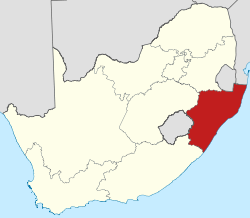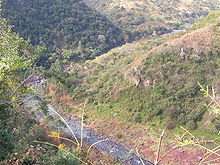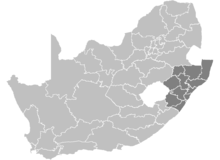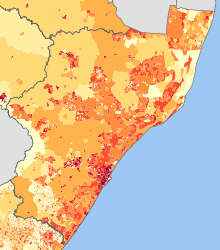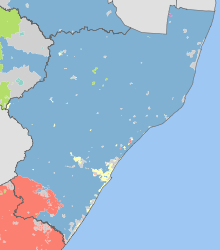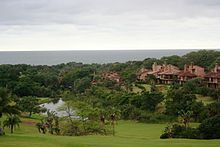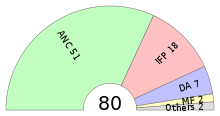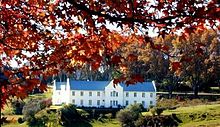- KwaZulu-Natal
-
This article is about a province of South Africa. For other and related uses, see Zululand.
KwaZulu-Natal — Province of South Africa — The Province of KwaZulu-Natal 
Coat of armsMotto: Masisukume sakhe (Let us rise and build) Location of KwaZulu-Natal in South Africa Country  South Africa
South AfricaNatalia Republic 12 October 1839 Colony of Natal 4 May 1843 Natal Province 31 May 1910 KwaZulu-Natal 27 April 1994 Capital Pietermaritzburg Districts ListGovernment – Type Parliamentary system – Premier Zweli Mkhize (ANC) Area[1] – Total 94,361 km2 (36,433 sq mi) Area rank 7th in South Africa Highest elevation 3,451 m (11,322 ft) Lowest elevation 0 m (0 ft) Population (2007)[2][3] – Total 10,259,230 – Estimate (2010) 10,645,400 – Rank 2nd in South Africa – Density 108.7/km2 (281.6/sq mi) – Density rank 2nd in South Africa Population groups[4] – Black African 86.0% – Indian or Asian 8.1% – White 4.4% – Coloured 1.4% Languages[5] – Zulu 80.0% – English 13.4% – Xhosa 3.5% – Afrikaans 1.5% Time zone SAST (UTC+2) ISO 3166 code ZA-ZN Website www.kwazulunatal.gov.za KwaZulu-Natal (
 /kwɑːˌzuːluː nəˈtɑːl/, also referred to as KZN or Natal) is a province of South Africa. Prior to 1994, the territory now known as KwaZulu-Natal was made up of the province of Natal and the homeland of KwaZulu.
/kwɑːˌzuːluː nəˈtɑːl/, also referred to as KZN or Natal) is a province of South Africa. Prior to 1994, the territory now known as KwaZulu-Natal was made up of the province of Natal and the homeland of KwaZulu.In the 1830s, the northern part was the Zulu Kingdom and southern part was briefly a Boer republic called Natalia (1839–1843). In 1843, the latter became the British Colony of Natal; Zululand (KwaZulu in Zulu) remained independent until 1879.
This region is the birthplace of many prominent South African politicians, such as Pixley ka Isaka Seme ( founder of ANC & 1st black lawyer in South Africa)',John Langalibalele Dube (Founding President of ANC),Mangosuthu Buthelezi (Founder of IFP),Chief Albert Luthuli ( ANC president and 1st African to receive Nobel peace prize), Anton Lembede (Founding President of ANCYL), Jacob Zuma(President of South Africa,Bhambatha.
It is called the garden province and is the home of the Zulu nation. Two natural areas: the iSimangaliso Wetland Park and the uKhahlamba Drakensberg Park, have been declared UNESCO World Heritage Sites. Located in the southeast of the country, the province has a long shoreline on the Indian Ocean. It borders three other provinces and the countries of Mozambique, Swaziland, and Lesotho. Its capital is Pietermaritzburg, and its largest city is Durban.
Contents
Geography
At around 92,100 km2 in area, Kwazulu Natal is roughly the size of Portugal. The province has three different geographic areas. The lowland region along the Indian Ocean coast is extremely narrow in the south, widening in the northern part of the province. The central region is the Natal Midlands, an undulating hilly plateau rising toward the west. Third are the two mountainous areas, the Drakensberg Mountains in the west and the Lebombo Mountains in the north. The Drakensberg range forms a solid wall of basalt rising over 3,000 m (9,800 ft) near the Lesotho border, whilst the Lebombo Mountains are ancient granite mountains, forming low parallel ranges running southward from Swaziland. The Tugela River flows west to east across the center of the province and is the region's largest river.
The coastal regions typically have subtropical thickets and deeper ravines; steep slopes host some Afromontane Forest. The midlands have moist grasslands and isolated pockets of Afromontane Forest. The north has a primarily moist savanna habitat, whilst the Drakensberg region hosts mostly alpine grassland.
The province contains rich areas of biodiversity of a range of flora and fauna. The iSimangaliso Wetland Park and the uKhahlamba Drakensberg Park have been declared UNESCO World Heritage Sites. The iSimangaliso Wetland Park, along with uKhahlamba Drakensberg Park and Ndumo, are wetlands of international importance for migratory species, and are designated as RAMSAR sites. South Africa signed the 1971 RAMSAR Convention to try to conserve and protect important wetlands because of their importance to habitats and numerous species.
The former Eastern Cape enclave of the town of Umzimkulu and its hinterland have been incorporated into KwaZulu-Natal following the 12th amendment of the Constitution of South Africa. The amendment also made other changes to the southern border of the province.
The northwesterly line of equal latitude and longitude traverses the province from the coast at Hibberdene at 30°34′35″S 30°34′35″E / 30.57639°S 30.57639°E to northeast Lesotho.
Climate
KwaZulu-Natal has a varied yet verdant climate thanks to diverse, complex topography. Generally, the coast is subtropical with inland regions becoming progressively colder. Durban on the south coast has an annual rainfall of 1009 mm, with daytime maxima peaking from January to March at 28 °C (82 °F) with a minimum of 21 °C (70 °F), dropping to daytime highs from June to August of 23 °C (73 °F) with a minimum of 11 °C (52 °F). Temperature drops towards the hinterland, with Pietermaritzburg being similar in the summer, but much cooler in the winter. Ladysmith in the Tugela River Valley reaches 30 °C (86 °F) in the summer, but may drop below freezing point on winter evenings. The Drakensberg can experience heavy winter snow, with light snow occasionally experienced on the highest peaks in summer. The Zululand north coast has the warmest climate and highest humidity, supporting many sugar cane farms around Pongola.
Borders
KwaZulu-Natal borders the following areas of Mozambique, Swaziland, and Lesotho:
- Maputo Province, Mozambique – far northeast
- Lubombo District, Swaziland – northeast, east of Shiselweni
- Shiselweni District, Swaziland – northeast, west of Lubombo
- Mokhotlong District, Lesotho – southwest, north of Thaba-Tseka
- Thaba-Tseka District, Lesotho – southwest, between Mokhotlong and Qacha's Nek
- Qacha's Nek District, Lesotho – southwest, south of Thaba-Tseka
Domestically, it borders the following provinces:
- Mpumalanga – north
- Free State – west
- Eastern Cape – southwest
Municipal structure
KwaZulu-Natal is divided into eleven districts. One of these, eThekwini (Durban and surrounding area), is a metropolitan municipality and the other ten are district municipalities. The local seat of each district municipality is given in parentheses.
- Amajuba (Newcastle)
- Zululand (Ulundi)
- Umkhanyakude (Mkuze)
- uThungulu (Richards Bay)
- Umzinyathi (Dundee)
- Uthukela (Ladysmith)
- Umgungundlovu (Pietermaritzburg)
- iLembe (kwaDukuza, formerly Stanger)
- eThekwini
- Ugu (Port Shepstone)
- Sisonke (Ixopo)
Coastline
The coastline is dotted with small towns, many of which serve as seasonal recreational hubs. The climate of the coastal areas is humid and subtropical, comparable to southern Florida in the United States, but not quite as hot and rainy in the summer. As one moves further north up the coast towards the border of Mozambique, the climate becomes almost purely tropical. North of Durban is locally referred to as "The North Coast", while south is "The South Coast". The Kwazulu-Natal Tourist board includes towns such as Margate, Port Shepstone, Scottburgh and Port Edward in its definition of the South Coast, while Ballito, Umhlanga and Salt Rock are North Coast resort towns.
Beaches of world-class quality are to be found along virtually every part of South Africa's eastern seaboard, with some of the least-developed gems found in the far southern and far northern ends of the province. Marina Beach (and its adjoining resort San Lameer) was recognised in 2002 as a Blue Flag beach.
Some visitors come for the annual late autumn or early winter phenomenon on the KwaZulu-Natal coast of the "sardine run". Referred to as "the greatest shoal on earth", the sardine run occurs when millions of sardines migrate from their spawning grounds south of the southern tip of Africa northward along the Eastern Cape coastline toward KwaZulu-Natal. They follow a route close inshore, often resulting in many fish washing up on beaches. The huge shoal of tiny fish can stretch for many kilometres; it is preyed upon by thousands of predators, including game fish, sharks, dolphins and seabirds. Usually the shoals break up and the fish disappear into deeper water around Durban. Scientists have been unable to answer many questions surrounding this exceptional seasonal event.
Hilly interior
The interior of the province consists largely of rolling hills from the Valley of a Thousand Hills to the Midlands. Their beauty has inspired literature. Alan Paton, in the novel Cry, the Beloved Country, wrote:
There is a lovely road that runs from Ixopo into the hills. These hills are grass-covered and rolling, and they are lovely beyond any singing of it. The road climbs seven miles (11 km) into them, to Carisbrooke; and from there, if there is no mist, you look down on one of the fairest valleys of Africa. About you there is grass and bracken and you may hear the forlorn crying of the titihoya, one of the birds of the veld. Below you is the valley of the Umzimkulu, on its journey from the Drakensberg to the sea; and beyond and behind the river, great hill after great hill; and beyond and behind them, the mountains of Ingeli and Griqualand East.History
Vasco da Gama of Portugal saw the coast of Natal on Christmas Day 1497. Natal is the Portuguese word for Christmas which gave rise to the European name for the region. The area was occupied centuries ago by the Nguni branch of the Bantu.
The first European settlers established a trading post called Port Natal in 1824 – these were mostly British settlers. These settlers made almost no attempt to develop the interior, whose inhabitants had been decimated by the Zulu chief Shaka (also spelled Chaka). The Afrikaner Voortrekkers entered the area via the Drakensberg passes in 1837. These Afrikaners defeated the Zulus at the Battle of Blood River in 1838 and thereafter established the Republic of Natal. Thus, the territory was once part of a short-lived Boer republic between 1839 and 1843 until its annexation by Britain. Many Afrikanner inhabitants left for the interior after the annexation and were replaced by immigrants, mainly from Britain. From 1860 onward, increasing numbers of Indians were brought in by the British mainly to work in the sugar plantations on the coast. The colony acquired Zululand (the area north of the Tugela River) after the Zulu War of 1879. The lands north of the Buffalo River were added in 1902. Boer forces entered the area during the South African War (1899 to 1902) – also known as the second Boer War- and laid siege to Ladysmith. They failed to build on their initial advantage and for three months the line between the opposing forces followed the course of the Tugela River. In 1910 the colony became a province of the Union of South Africa and in 1961 of the Republic of South Africa.
When the homeland of KwaZulu, which means "Place of the Zulu" was re-incorporated into the Natal province after the end of apartheid in 1994, the province of Natal, which had existed between 1910 and 1994, was renamed KwaZulu-Natal. The province is home to the Zulu monarchy; the majority population and language of the province is Zulu. It is the only province in South Africa that has the name of its dominant ethnic group as part of its name.
Provincial coat of arms
The supporters, the lion and the wildebeest, are symbols of the regions that were joined to create KwaZulu-Natal, KwaZulu and Natal, respectively.[6] The zig-zag stripe is representative of the Drakensberg.[6] The star represents the coastline, named Natalia by Vasco da Gama on Christmas day, 1497, as well as the Zulu myth that the Zulu people are "people of heaven" or "star people".[6] The strelitzia flower on the shield is a symbol of the province's beauty.[6] The assegai and knobkierrie behind the shield represent peace and protection.[6] The crown base is a headring, traditionally worn by Zulu elders and representing wisdom and maturity. The crown is a round grass hut built in the Zulu style. The motto is Masisukume Sakhe, Zulu for "Let Us Stand Up and Build".[6]
Law and government
Provincial government
The KwaZulu-Natal's provincial government sits in the legislative buildings in Pietermaritzburg. The foundation stone of the new legislative building was laid on 21 June 1887, to commemorate Queen Victoria's Golden Jubilee. The building was completed two years later. On 25 April 1889, the Governor of Natal, Sir Arthur Havelock, opened the first Legislative Council session in the new building.
This was the former site of St Mary's Church, built in the 1860s. The congregation built a new church in 1884 at the corner of Burger Street and Commercial Road. The old building was demolished in 1887 to provide space for the legislative complex.
When governance was granted to Natal in 1893, the new Legislative Assembly took over the chamber used by the Legislative Council since 1889. Further extensions to the parliamentary building were made. The building was unoccupied until 1902, when it was used without being officially opened, due to the country's being engulfed in the Anglo-Boer war. The war forced the Legislative Assembly to move the venue of its sittings, as its chamber was used as a military hospital.
 The KwaZulu-Natal parliament building, located in Pietermaritzburg, South Africa
The KwaZulu-Natal parliament building, located in Pietermaritzburg, South Africa
The Legislative Assembly and the Legislative Council buildings have both been designated national monuments. They formed a colonial Parliament of two houses: a Council of 11 nominated members and an Assembly of 37 elected members. The Natal Parliament was disbanded in 1910 when the Union of South Africa was formed, and the Assembly became the meeting place of the Natal Provincial Council. The Council was disbanded in 1986.
The Provincial Legislature consists of 80 Members.
Current composition of the legislature
The African National Congress (ANC) hold power in the provincial legislature, winning the province with a convincing overall majority in South Africa's 2009 elections. Their chief opponents were the Inkatha Freedom Party, allied with the Democratic Alliance.
Breakup of the 80-seat legislature from the 2009 elections:
- African National Congress (ANC): 51
- Inkatha Freedom Party (IFP); 18
- Democratic Alliance (DA): 7
- Minority Front (MF): 2
- African Christian Democratic Party (ACDP): 1
- Congress of the People (COPE): 1
Zulu monarch
KwaZulu-Natal is the home to the Zulu monarch, King Goodwill Zwelithini kaBhekuzulu. Although not holding any direct political power, the Zulu king is provided a stipend by the government. He holds considerable influence among the more traditionalist Zulu people in the province.
To date the Zulu king has six wives; traditionally, each year a ceremony is performed in which the king receives another wife. This was formerly a way of creating connections among the various peoples. The current King practices the ceremony, called the "Reed Dance", but has not chosen new wives recently. Instead, he has used the occasion to promote abstinence until marriage as a way of preserving Zulu culture and preventing the spread of HIV/AIDS.
Economy
Durban is a rapidly growing urban area and is by most measures the busiest port in Africa. A good railway network links the city to other areas of Southern Africa. Sugar refining is Durban's main industry. Sheep, cattle, dairy, citrus fruits, corn, sorghum, cotton, bananas, and pineapples are also raised. There is an embryonic KwaZulu-Natal wine industry. Other industries (located mainly in and around Durban) include textile, clothing, chemicals, rubber, fertiliser, paper, vehicle assembly and food-processing plants, tanneries, and oil refineries. There are large aluminium-smelting plants at Richards Bay, on the north coast.[citation needed]
To the north, Newcastle is the province's industrial powerhouse, with Mittal Steel South Africa (previously ISPAT/ISCOR) and the Karbochem synthetic rubber plant dominating the economy. In 2002, Newcastle became the largest producer of chrome chemicals in Africa with the completion of a chrome-chemical plant, a joint-venture project between Karbochem and German manufacturing giant Bayer. Other large operations include a diamond-cutting works, various heavy engineering concerns, the Natal Portland Cement (NPC) slagment cement factory, and the Ingagane Power Station. This was recommissioned as Africa's first gas-fired power station by Independent Power Southern Africa (IPSA), and it supplies the Karbochem Plant with electricity. The textile industry is a major employer in the Newcastle area, with over 100 factories belonging to ethnic Taiwanese and Chinese industrialists. Maize, livestock and dairy farmers operate on the outskirts of the city. Coal is also mined in the Newcastle area. The province as a whole produces considerable amounts of coal (especially coke) and timber.[citation needed]
Offshore mining of heavy minerals and precious metals including rutile, ilmenite, zircon and iron ore are threatening the marine ecology of KwaZulu-Natal's coast, including the Tugela Banks; the fishing economy of the prawn and nurse fisheries are also threatened.[citation needed]
About 86% of the population is Black African. During apartheid, a large percentage of native blacks was forced to live in Bantu homelands (Bantustans), which had a subsistence economy based on cattle raising and corn growing.[citation needed]
Ecology tourism is increasingly important to the economy of KwaZulu-Natal. The area's rich biodiversity and efforts at conservation have been recognised. Tourists have come to see the iSimangaliso Wetland Park and the uKhahlamba Drakensberg Park, declared UNESCO World Heritage Sites. These two major parks and that of Ndumo have wetlands of international importance listed as RAMSAR sites for conservation. Tourists pay up to $10,000 for safaris on which they might see lions, elephants and giraffes. Others come to hike in the mountains or explore the wetlands with guides.[citation needed]
Prominent organisations
Prominent civil society organisations based in the province of KwaZulu-Natal include: Abahlali baseMjondolo (shackdwellers') movement,[7] the Diakonia Council of Churches,[8] the Right2Know campaign,[9] and the Unemployed People's Movement.[10]
HIV prevalence
One of the most urgent crises facing the province is the unparalleled prevalence of HIV infection among its citizens. South Africa as a whole has more HIV-positive citizens than any other nation.[11] Among South Africa's provinces, KwaZulu-Natal has the highest rate of HIV infection: 39 percent, according to UNAIDS in 2009.[12]
Without the proper nutrition, health care and medicine that is available in developed countries, large numbers of people suffer and die from AIDS-related complications. In some heavily infected areas, the epidemic has disrupted society, with fatalities high among adults in their prime, and leaving many orphans to be cared for by elderly grandparents. HIV/AIDS has retarded economic growth by destroying human capital.[13]
Education
As of the 2001 census, 22.9% of KwaZulu-Natal's population 20 years or older had received no education; only 4.8% had received some form of higher education.
Private schools
KZN has several of South Africa's private schools, including Hilton College and Michaelhouse in the midlands as well as Kearsney College and Thomas More College in the outlying suburbs of Durban. Other private schools include:
- Al Falaah College
- Clifton College
- Dar-ul-loom Newcastle (Institute for Islamic Studies)
- Durban Girls' College
- Cemal Karacan Star Colle
- Eden College Durban
- Epworth School
- Hilton College
- Kearsney College
- Maris Stella School
- Michaelhouse
- Oakridge College
- St. Anne's Diocesan College
- St. Charles College
- St. Dominics Academy, Newcastle
- St. Henry's Marist Brothers' College
- St. John's DSG
- St. Mary's DSG
- Thomas More College
- The Wykeham Collegiate
- Star college
- Treverton College
- Crawford North Coast College
- Our Lady of Fatima Convent School
Universities
- University of KwaZulu-Natal, merger of the University of Natal and the University of Durban-Westville
- University of Zululand
- Durban University of Technology, merger of ML Sultan Technikon and Technikon Natal
- Mangosuthu University of Technology
Sport
Notable sports events
- Comrades Marathon – An annual marathon run between Pietermaritzburg and Durban..
- Midmar Mile – A mile-long swimming race held annually at Midmar Dam
- Dusi Canoe Marathon – An annual canoe marathon, starting in Pietermaritzburg and ending in Durban.
- Durban July – South Africa's premier annual horse racing event at Greyville Racecourse in Durban.
- Mr Price Pro – a premier international surfing event at Durban during winter, previously known as the Gunston 500.
Provincial sports teams
- Football
- Premier Soccer League (PSL), currently featuring the following teams from the province:
- AmaZulu and Golden Arrows, from Durban
- Thanda Royal Zulu from Richards Bay
- Maritzburg United, from Pietermaritzburg
- Premier Soccer League (PSL), currently featuring the following teams from the province:
- Rugby union
- The Sharks, who compete in the Super Rugby competition alongside four other South African teams, five teams from Australia, and five from New Zealand
- Natal Sharks (closely connected to, but not to be confused with the Super Rugby team), who compete in South Africa's domestic competition, the Currie Cup
- Cricket
- Dolphins, the successor to KwaZulu-Natal, who compete in South Africa's domestic first-class competition, the SuperSport Series
References
- ^ Stats in Brief, 2010. Pretoria: Statistics South Africa. 2010. p. 3. ISBN 978-0-621-39563-1. http://www.statssa.gov.za/publications/StatsInBrief/StatsInBrief2010.pdf.
- ^ "Community Survey 2007: Basic results" (PDF). Statistics South Africa. p. 2. http://www.statssa.gov.za/publications/CS2007Basic/CS2007Basic.pdf. Retrieved 14 January 2011.
- ^ Mid-year population estimates, 2010 (Report). Statistics South Africa. 2010. http://www.statssa.gov.za/publications/P0302/P03022010.pdf. Retrieved 14 January 2011.
- ^ "Statistical release P0301: Community Survey, 2007 (Revised version)" (PDF). Statistics South Africa. p. 25. http://www.statssa.gov.za/publications/P0301/P0301.pdf. Retrieved 7 October 2009.
- ^ "Table: Census 2001 by province, language, population group and gender.". Census 2001 Interactive Tables. Statistics South Africa. http://www.statssa.gov.za/timeseriesdata/pxweb2006/Dialog/varval.asp?ma=Language%20by%20province&ti=Table%3A+Census+2001+by+province%2C+language%2C+population+group+and++gender%2E&path=../Database/South%20Africa/Population%20Census/Census%202001%20-%20NEW%20Demarcation%20boundaries%20as%20at%209%20December%202005/Provincial%20level%20-%20Persons/&lang=1. Retrieved 28 January 2010.
- ^ a b c d e f 2006, My Country South Africa – celebrating our national symbols and heritage, Department of Education, ISBN 1-77018-108-3
- ^ Churches want justice
- ^ Churches Ask Parties to Preach Tolerance
- ^ 200 march against Information Bill
- ^ No mercy, no grants, says Mkhize
- ^ Dugger, Celia W. (30 September 2009). "U.N. Cites Global Rise in Detection and Treatment of AIDS". New York Times (New York): p. A12. http://www.nytimes.com/2009/10/01/world/01aids.html. Retrieved 14 June 2011.
- ^ Dugger, Celia W. (19 July 2009). "South Africa Is Seen to Lag in H.I.V. Fight". New York Times. http://www.nytimes.com/2009/07/20/world/africa/20circumcision.html?scp=3&sq=kwazulu-natal&st=cse. Retrieved 10 July 2009.
- ^ Bell C, Devarajan S, Gersbach H (2003) (PDF). The long-run economic costs of AIDS: theory and an application to South Africa. World Bank Policy Research Working Paper No. 3152. http://www1.worldbank.org/hiv_aids/docs/BeDeGe_BP_total2.pdf. Retrieved 28 April 2008.
External links
Province of KwaZulu-Natal, South Africa Provincial Capital: PietermaritzburgMetropolitan
MunicipalitiesDistrict
and Local
MunicipalitiesVulamehlo · uMdoni · Umzumbe · uMuziwabantu · Ezingoleni · Hibiscus CoastEmnambithi-Ladysmith · Indaka · Umtshezi · Okhahlamba · ImbabazaneNewcastle · eMadlangeni · DannhauseruMhlabuyalingana · Jozini · The Big Five False Bay · Hlabisa · MtubatubaIngwe · Kwa Sani · Greater Kokstad · Ubuhlebezwe · Umzimkhulu Administrative divisions of South Africa
Administrative divisions of South AfricaProvinces Eastern Cape • Free State • Gauteng • KwaZulu-Natal • Limpopo • Mpumalanga • North West • Northern Cape • Western Cape
Municipalities Buffalo City (East London) · Cape Town · Ekurhuleni (East Rand) · eThekwini (Durban) · Johannesburg · Mangaung (Bloemfontein) · Nelson Mandela Bay (Port Elizabeth) · Tshwane (Pretoria)of the Eastern Cape · of the Free State · of Gauteng · of KwaZulu-Natal · of Limpopo · of Mpumalanga · of the North West · of the Northern Cape · of the Western Cape · Full listSettlements in the Eastern Cape · in the Free State · in Gauteng · in KwaZulu-Natal · in Limpopo · in Mpumalanga · in the North West · in the Northern Cape · in the Western CapeCategories:- KwaZulu-Natal
- Provinces of South Africa
- 1856 in South Africa
- States and territories established in 1994
Wikimedia Foundation. 2010.

